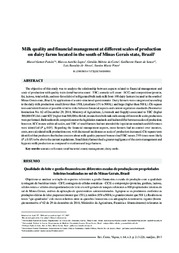Milk quality and financial management at different scales of production on dairy farms located in the south of Minas Gerais State, Brazil.
Milk quality and financial management at different scales of production on dairy farms located in the south of Minas Gerais State, Brazil.
Author(s): PAIXÃO, M.; LOPES, M.; COSTA, G. M. da; SOUZA, G. N. de; ABREU, L. R. de; PINTO, S. M.
Summary: The objective of this study was to analyze the relationship between aspects related to financial management and The objective of this study was to analyze the relationship between aspects related to financial management and scale of production with quality traits (total bacteria count - TBC; somatic cell count - SCC) and composition (protein, fat, lactose, total solids, and non-fat solids) of refrigerated bulk tank milk from 100 dairy farmers located in the south of Minas Gerais state, Brazil, by application of a semi-structured questionnaire. Dairy farmers were categorized according to the daily milk production: small (lower than 150 L); medium (151 to 500 L); and large (higher than 501 L). Chi-square tests and identification of possible relative risks between financial aspects and current regulation standards (Normative Instruction No. 62 of December 29, 2011, Ministry of Agriculture, Livestock and Supply) associated to TBC (higher 300,000 CFU/mL) and SCC (higher than 500,000 cells/mL) means from bulk tank milk among different milk scales productions were performed. Bulk tanks milk composition met the legislation standards and had not differ between scales of production; however, SCC means within all scales, and TBC of small farmers had not attended the legislation standards and differences were identified (P < 0.05). Regarding the financial management aspects, most farmers had no control over incomes, costs, nor calculated milk production cost, with decreased incidences as scale of production increased. Chi-square tests identified that producers that had no concern about milk quality payment bonuses had TBC means 2.95 times more likely (P < 0.05) to be above the current regulations. Small dairy farmers had a greater negligence of the costs management and hygienic milk production as compared to medium and large farmers. scale of production with quality traits (total bacteria count - TBC; somatic cell count - SCC) and composition (protein, fat, lactose, total solids, and non-fat solids) of refrigerated bulk tank milk from 100 dairy farmers located in the south of Minas Gerais state, Brazil, by application of a semi-structured questionnaire. Dairy farmers were categorized according to the daily milk production: small (lower than 150 L); medium (151 to 500 L); and large (higher than 501 L). Chi-square tests and identification of possible relative risks between financial aspects and current regulation standards (Normative Instruction No. 62 of December 29, 2011, Ministry of Agriculture, Livestock and Supply) associated to TBC (higher 300,000 CFU/mL) and SCC (higher than 500,000 cells/mL) means from bulk tank milk among different milk scales productions were performed. Bulk tanks milk composition met the legislation standards and had not differ between scales of production; however, SCC means within all scales, and TBC of small farmers had not attended the legislation standards and differences were identified (P < 0.05). Regarding the financial management aspects, most farmers had no control over incomes, costs, nor calculated milk production cost, with decreased incidences as scale of production increased. Chi-square tests identified that producers that had no concern about milk quality payment bonuses had TBC means 2.95 times more likely (P < 0.05) to be above the current regulations. Small dairy farmers had a greater negligence of the costs management and hygienic milk production as compared to medium and large farmers.
Publication year: 2017
Types of publication: Journal article
Unit: Embrapa Dairy Cattle
Keywords: Management, Total bacterial count, dairy cattle, somatic cell count
Observation
Some of Embrapa's publications are published as ePub files. To read them, use or download one of the following free software options to your computer or mobile device. Android: Google Play Books; IOS: iBooks; Windows and Linux: Calibre.
Access other publications
Access the Agricultural Research Database (BDPA) to consult Embrapa's full library collection and records.
Visit Embrapa Bookstore to purchase books and other publications sold by Embrapa.

